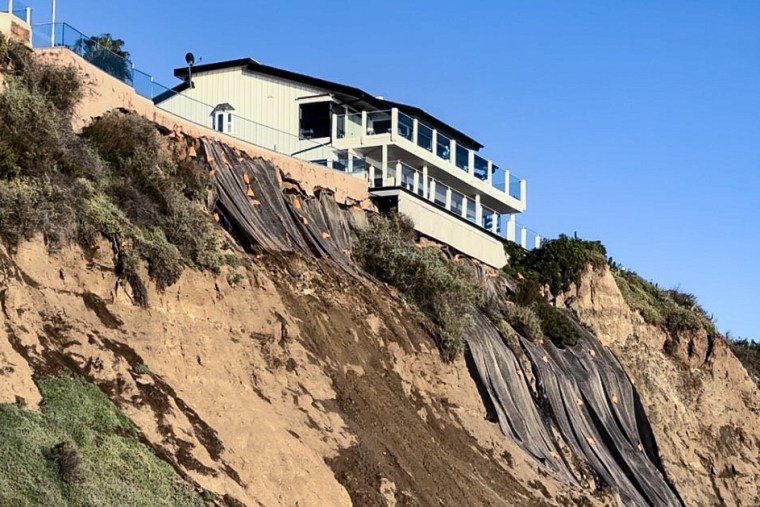
In the community of Rancho Palos Verdes, a landslide-prone coastal city in Los Angeles County, the recent rains have accelerated the movement of land and caused shifts in places where slides have not been mapped before, according to a city news release.
Onderdonk said that layers of sedimentary rock in the area are tilted toward the sea. When weak layers of clay become saturated with water, they expand and often slide because they have very little friction.
The intense season of rainfall has heightened and expanded which areas are of concern. Decades ago, geologists drew up a plan to dewater slopes in the Abalone Cove landslide area, slowing movement considerably, Onderdonk said.
But about a week ago, accelerating movement forced the closure of the Wayfarers Chapel, a Frank Lloyd Wright Jr.-designed national historic landmark in Abalone Cove.
“That caught my attention,” Onderdonk said. “This is an area that had apparently been stabilized.”
With homes and roads at risk, the city of Rancho Palos Verdes has requested Gov. Gavin Newsom pursue state and federal emergency declarations, which could speed emergency fixes through the permitting process.
Many coastal cities along the California coast are exposed to landslide risk.

Houses in Dana Point grabbed headlines this week after The Los Angeles Times and other media organizations published drone footage showing several large seaside houses perched above landslide debris.
Scientists are still investigating how climate change will alter the frequency and severity of landslides. A 2022 study published in the peer-reviewed journal Geophysical Research Letters found that landslides are sensitive to changes in the climate and move much faster in wet years than dry years.
A 2019 study published in the Bulletin of the American Meteorological Society, found that landslides coincided with atmospheric river storms about 76% of the time in the San Francisco Bay area.
Scientists say atmospheric river storms are becoming more frequent and intense on the West Coast, because a warmer atmosphere can absorb and transport more water vapor.
California’s bluffs are fighting more than gravity.
Rising seas and more intense storms are chewing away at the state’s beaches and shoreline, something climate scientists have warned about for years. A United States Geological Survey report found that with sea levels rising because of climate change, Southern California could lose up to two-thirds of its beaches by 2100.
Global warming — which is driven by human-use of fossil fuels — is the primary cause of sea level rise. Melting glaciers and polar ice sheets are raising sea levels. Ocean water is also expanding in volume as it becomes warmer.
It’s a dynamic that’s left many watching their beaches shrink.

Homeowners Edward and Debbie Winston-Levin, who live in Dana Point, California, in a home that overlooks Capistrano Beach, said they’ve watched the sea wash away over time.
“There used to be a volleyball court and a basketball court down there that all have been eroded,” Edward Winston-Levin, 77, said. “And on a high-surf day, it covers the parking lot.”
They worry their property, which is on a steep slope, could one day slide into the sea.
“If one slide starts, it’s going to go on, we’re going to lose our houses with, you know, beautiful views,” he said.
Many coastal cities are making drastic changes to try to adapt.
In San Diego, plans are underway in the beach town of Del Mar to move the train tracks that are now considered too close to the coast. And in San Clemente, the state is planning to build a $7.2 million wall to fortify a landslide area in an effort to hold back a slipping hillside that has closed down the train service through Orange County.
In Isla Vista near UC Santa Barbara, a collapsing cliff recently forced students to evacuate their homes and now several of those buildings are being rebuilt further from the shore.
Experts say overtime this changing landscape could lead to a dilemma: save the state’s iconic beaches or wall them off to protect the cliffside homes.
“That’s a very complex question,” Phipps said. “Obviously, Californians love their beaches and everyone’s going to want to keep their beaches, and there’s going to be places where that’s possible, but a lot of places, beaches are being narrowed and lost.”
 Print
Print




